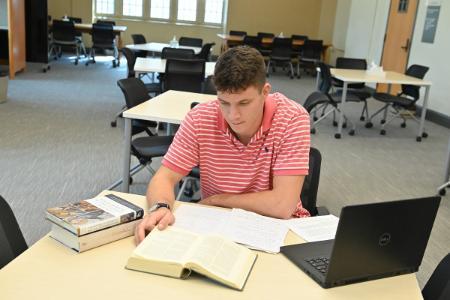Adams Researches Tolkien’s Contribution to Biblical Translation

John Paul Adams ’27 researches J.R.R. Tolkien’s translation of the Old Testament book of Jonah in Preston Library. –VMI Photo by Kelly Nye.
LEXINGTON, Va., July 28, 2025—English writer, scholar, and University of Oxford professor, J.R.R. Tolkien, is most famous for his fictional works including, “The Hobbit” and “The Lord of the Rings,” but few people are aware he translated the Old Testament book of Jonah for the Jerusalem Bible. John Paul Adams ’27, an English major minoring in French at Virginia Military Institute, spent 10 weeks studying the background and significance of the Jerusalem Bible and Tolkien’s role in its publication for his Summer Undergraduate Research Institute (SURI) project, “Scriptural Monster: A Study of Tolkien’s Jonah.”
The Jerusalem Bible, first published in 1956 as La Bible de Jérusalem, is a Roman Catholic translation of the Bible. Members of the Dominican Order at the École Biblique in Jerusalem, translated the original Hebrew and Greek texts of scripture into their native language of French. Adams shared that an English priest had read the notes of the Dominicans and wanted to publish a similar translation in English but realized a lack of scholars fluent in the languages to be well equipped to translate the Scriptures from the original text. “That’s where Tolkien fits in. The priest wanted Tolkien to be involved in the project because he knew of Tolkien’s fame as a philologist [the study of literary texts and written records,] and as someone who translated ‘Beowulf’ and other old English works, who was a Latin and Greek scholar, and who knew French. He thought Tolkien would be a powerhouse for this Bible.”
Though there were plans of Tolkien translating more books of the Bible, he only translated Jonah. According to Adams, there is no clear explanation why he started with Jonah. “He may have started with Jonah because it’s short. He quickly drafted that one to send back to get approval for more translations. What I like about it is that it fits in really well with Tolkien’s ethos, because it’s a very mythical book of the Bible, and it’s got a lot of fairy tale elements that Tolkien used in his essays and in his fiction.”
Adams shared that Tolkien had presented a copy of “The Lord of the Rings” to the editor of the Bible before he started translating. “The editor responded, ‘This is wonderful. I wish we had a whole Bible written in this style.’ Interestingly, the translation doesn’t really use that style at all. It’s a very literal one-for-one translation. For example, there’s a poem in the scripture, which Tolkien translates as prose, just to stay one-for-one. He has a lot of poetry in his fiction, and one may have expected him to write the poem, translating in poetry. I think he had this idea that he didn’t want to focus necessarily on the meaning of the words. He wanted to focus on the words themselves, because he wanted them to speak for themselves. He may have been worried that if he tried to be more literary rather than literal, that he would lose something in that translation. I think that plays into his ideas of allegory, which he did not like. He made it clear that his works of fiction were not allegorical, even though a lot of people claimed they were.”
The English translation of the Jerusalem Bible was published in 1966.
Adam’s faculty mentor, Col. Steven Knepper, professor in the Department of English, Rhetoric, and Humanistic Studies, and the Bruce C. Gottwald Jr. ’81 Chair for Academic Excellence, stated that Adams’ project makes a real contribution to Tolkien scholarship. “His close analysis of Tolkien’s translation choices suggest that Tolkien emphasizes mercy as the major theme of Jonah, and Adams shows how this resonates with the literary and theological vision of Tolkien’s famous works about Middle-earth. To complete this project, Adams has had to draw on textual editing, literary analysis, biographical research, biblical studies, and theology. Since Tolkien was working from a French source text, Adams also had to use his French language skills, and met with both Col. Abbey Carrico, head of the Department of Modern Languages and Cultures, and Col. Jeff Kendrick, director of the Office of Global Education, for guidance in this area. His project is a great example of interdisciplinary research in the humanities.”
Adams plans to present his paper at the VMI Undergraduate Research Symposium during spring semester, and hopes to get it published in one of several possible academic journals including, Tolkien Studies: An Annual Scholarly Review.
As an English major, Adams’ concentrations are philosophy, rhetoric and writing, and literary studies. He serves on VMI’s Honor Court, is captain of the rugby club, president of the Thomistic Institute chapter, and sings in Washington and Lee’s student choir at St. Patrick’s Catholic Church in Lexington. He is a graduate of Gregory the Great Academy in Elmhurst, Pennsylvania, where he was first exposed to Tolkien and “The Lord of the Rings” by his theology professor, Dr. Nathan Lefler. Adams is the son of Jeffrey and Karen Adams of Staunton, Virginia. Following graduation, he will commission into the Army.
Marianne Hause
Communications & Marketing
VIRGINIA MILITARY INSTITUTE
.svg)
.png)